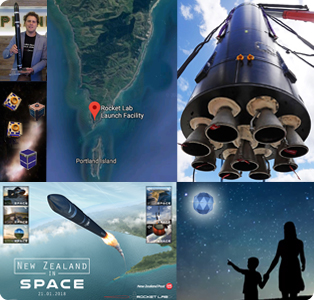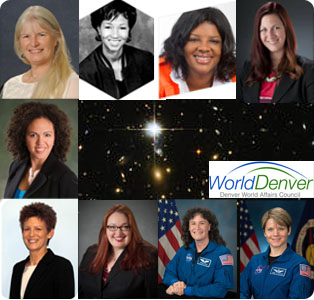Rocket Lab Preparing 3rd Launch Possibly in March, Tracking Humanity Star
|
MONDAY Ongoing…
|

![]() = All times
= All times
for terrestrial events in local time unless noted.
![]() = All times for international terrestrial events in local time unless noted.
= All times for international terrestrial events in local time unless noted.
![]() = All times for space events, and…
= All times for space events, and…
![]() = All times for international space / astro events in Hawaii Standard Time unless noted. Add 10 hours to obtain UT (‘Universal Time’).
= All times for international space / astro events in Hawaii Standard Time unless noted. Add 10 hours to obtain UT (‘Universal Time’).
Weekly Planet Watch – Evening Planets: Venus (WSW), Uranus (SW); Morning Planets: Mars (ESE), Jupiter (ESE), Saturn (SE).
WorldDenver to Host Gala Focusing on Women in Space
|
Continued from…
TUESDAY
|
![]() Mar 6 — SpaceX, Launch Falcon 9 / Hispasat 30W-6, Cape Canaveral AFS FL: Falcon 9 rocket to launch Hispasat 30W-6 communications satellite for Madrid-based Hispasat.
Mar 6 — SpaceX, Launch Falcon 9 / Hispasat 30W-6, Cape Canaveral AFS FL: Falcon 9 rocket to launch Hispasat 30W-6 communications satellite for Madrid-based Hispasat.
![]() Mar 6-7 — The National Academies, Washington DC: Meeting: Exoplanet Science Strategy.
Mar 6-7 — The National Academies, Washington DC: Meeting: Exoplanet Science Strategy.
![]() Mar 6-8 — Applied Technology Institute, Columbia MD: ATI Course: Satellite Communications Systems – Advanced; instructor Bruce Elbert, founder of Application Technology Strategy LLC.
Mar 6-8 — Applied Technology Institute, Columbia MD: ATI Course: Satellite Communications Systems – Advanced; instructor Bruce Elbert, founder of Application Technology Strategy LLC.
![]() Mar 6-8 — The National Academies, Washington DC: Meeting: Astrobiology Science Strategy for the Search for Life in the Universe.
Mar 6-8 — The National Academies, Washington DC: Meeting: Astrobiology Science Strategy for the Search for Life in the Universe.
![]() Mar 6-8 — National Astronomical Observatory of Japan (NAOJ), Tokyo, Japan: 8th DTA Symposium: Challenge to Super-Earths and Their Atmospheres – Where Do They Come From?
Mar 6-8 — National Astronomical Observatory of Japan (NAOJ), Tokyo, Japan: 8th DTA Symposium: Challenge to Super-Earths and Their Atmospheres – Where Do They Come From?
![]() Mar 6 — Moon: 4.0° NNE of Jupiter, 23:00.
Mar 6 — Moon: 4.0° NNE of Jupiter, 23:00.
WEDNESDAY
![]() Mar 7 — Humanity Star, LEO: Potential optimal viewing for Rocket Lab Humanity Star tonight from Hawai`i island SSE at about 19:30.
Mar 7 — Humanity Star, LEO: Potential optimal viewing for Rocket Lab Humanity Star tonight from Hawai`i island SSE at about 19:30.
![]() Mar 7 — Kepler, Heliocentric Orbit: Craft searching for exoplanets begins 10th year in space today; operating in K2 extension mission after two reaction wheels failed altering original mission goals; launched 2009.
Mar 7 — Kepler, Heliocentric Orbit: Craft searching for exoplanets begins 10th year in space today; operating in K2 extension mission after two reaction wheels failed altering original mission goals; launched 2009.
![]() Mar 7 — Journey Through the Universe, W. M. Keck Observatory, Rob and Terry Ryan Foundation, Kamuela HI: Astronomy Talk: Journey Through the Universe: Landscapes of the Moon and Mars; by Brian Day, of SSERVI / NASA Ames Research Center; at HPA, 19:00.
Mar 7 — Journey Through the Universe, W. M. Keck Observatory, Rob and Terry Ryan Foundation, Kamuela HI: Astronomy Talk: Journey Through the Universe: Landscapes of the Moon and Mars; by Brian Day, of SSERVI / NASA Ames Research Center; at HPA, 19:00.
![]() Mar 7 — MIT Museum, Cambridge MA: Book Talk: Sunburst and Luminary: An Apollo Memoir; author and MIT I-Lab computer scientist Don Eyles, 18:00-19:30.
Mar 7 — MIT Museum, Cambridge MA: Book Talk: Sunburst and Luminary: An Apollo Memoir; author and MIT I-Lab computer scientist Don Eyles, 18:00-19:30.
![]() Mar 7 — Goddard Space Flight Center, Greenbelt MA: Colloquium: The Chicxulub Asteroid Impact and the K-Pg Extinction; Rolando Garcia from National Center for Atmospheric Research, 15:30.
Mar 7 — Goddard Space Flight Center, Greenbelt MA: Colloquium: The Chicxulub Asteroid Impact and the K-Pg Extinction; Rolando Garcia from National Center for Atmospheric Research, 15:30.
![]() Mar 7 — Apollo Asteroid 2017 VR12: Near-Earth Flyby (0.010 AU).
Mar 7 — Apollo Asteroid 2017 VR12: Near-Earth Flyby (0.010 AU).
![]() Mar 7 — Aten Asteroid 2003 EM1: Near-Earth Flyby (0.043 AU).
Mar 7 — Aten Asteroid 2003 EM1: Near-Earth Flyby (0.043 AU).
THURSDAY
![]() Mar 8 — WorldDenver, Kaiser Permanente, Ball Aerospace, Lockheed Martin, et al, Denver CO: International Women’s Day – Women in Space; featuring Astronaut Dr. Mae Jemison and SWF President Cynda Collins Arsenault.
Mar 8 — WorldDenver, Kaiser Permanente, Ball Aerospace, Lockheed Martin, et al, Denver CO: International Women’s Day – Women in Space; featuring Astronaut Dr. Mae Jemison and SWF President Cynda Collins Arsenault.
![]() Mar 8 — Moon: 9.3° N of Antares, 08:00.
Mar 8 — Moon: 9.3° N of Antares, 08:00.
![]() Mar 8 — Apollo Asteroid 2015 FM34: Near-Earth Flyby (0.058 AU).
Mar 8 — Apollo Asteroid 2015 FM34: Near-Earth Flyby (0.058 AU).
![]() Mar 8 — Apollo Asteroid 2018 CC14: Near-Earth Flyby (0.064 AU).
Mar 8 — Apollo Asteroid 2018 CC14: Near-Earth Flyby (0.064 AU).
FRIDAY
![]() Mar 9 — Royal Astronomical Society, London, United Kingdom: Royal Astronomical Society Ordinary Meeting; Meeting: Ground Effects of Severe Space Weather Events; Meeting: Merging Giant-Star Asteroseismology with the Fate of Extrasolar Planetary Systems.
Mar 9 — Royal Astronomical Society, London, United Kingdom: Royal Astronomical Society Ordinary Meeting; Meeting: Ground Effects of Severe Space Weather Events; Meeting: Merging Giant-Star Asteroseismology with the Fate of Extrasolar Planetary Systems.
![]() Mar 9-10 — Space Generation Advisory Council, Politehnica University, ESA, Bucharest, Romania: 3rd European Space Generation Workshop; 100 delegates to network, exchange know-how, share best practices and nurture the next generation’s perspective on space matters.
Mar 9-10 — Space Generation Advisory Council, Politehnica University, ESA, Bucharest, Romania: 3rd European Space Generation Workshop; 100 delegates to network, exchange know-how, share best practices and nurture the next generation’s perspective on space matters.
![]() Mar 9 — Moon: At last quarter, 01:22; 11.8° S of 4 Vesta, 08:44; 3.8° N of Mars, 15:00.
Mar 9 — Moon: At last quarter, 01:22; 11.8° S of 4 Vesta, 08:44; 3.8° N of Mars, 15:00.
![]() Mar 9 — Apollo Asteroid 2018 BK7: Near-Earth Flyby (0.026 AU).
Mar 9 — Apollo Asteroid 2018 BK7: Near-Earth Flyby (0.026 AU).
SATURDAY
![]() Mar 10 — Mars Reconnaissance Orbiter, Mars Orbit: NASA spacecraft begins 13th year in Mars orbit today, continues to study seasonal changes on planet circling at 300-km near-polar orbit; launched Aug 12, 2005, entered orbit Mar 10, 2006.
Mar 10 — Mars Reconnaissance Orbiter, Mars Orbit: NASA spacecraft begins 13th year in Mars orbit today, continues to study seasonal changes on planet circling at 300-km near-polar orbit; launched Aug 12, 2005, entered orbit Mar 10, 2006.
![]() Mar 8 — Jet Propulsion Laboratory, NASA/Caltech, Pasadena CA: Educator Workshop: The InSight Mission – Quakes on Mars; for teachers grades K-12 and all educators.
Mar 8 — Jet Propulsion Laboratory, NASA/Caltech, Pasadena CA: Educator Workshop: The InSight Mission – Quakes on Mars; for teachers grades K-12 and all educators.
![]() Mar 10 — Daylight Saving Time (USA): Set clock ahead 1 hour; does not include Hawai’i, American Samoa or Arizona (except the Navajo Reservation).
Mar 10 — Daylight Saving Time (USA): Set clock ahead 1 hour; does not include Hawai’i, American Samoa or Arizona (except the Navajo Reservation).
![]() Mar 10 — Moon: 2.2° N of Saturn, 16:00; at apogee (distance 404,682 km), 23:00.
Mar 10 — Moon: 2.2° N of Saturn, 16:00; at apogee (distance 404,682 km), 23:00.
![]() Mar 10 — Apollo Asteroid 2015 DK200: Near-Earth Flyby (0.018 AU).
Mar 10 — Apollo Asteroid 2015 DK200: Near-Earth Flyby (0.018 AU).
![]() Mar 10 — Apollo Asteroid 2007 LU19: Near-Earth Flyby (0.052 AU).
Mar 10 — Apollo Asteroid 2007 LU19: Near-Earth Flyby (0.052 AU).
![]() Mar 10 — Apollo Asteroid 2003 DY15: Near-Earth Flyby (0.058 AU).
Mar 10 — Apollo Asteroid 2003 DY15: Near-Earth Flyby (0.058 AU).
![]() Mar 10 — Aten Asteroid 2007 CM26: Near-Earth Flyby (0.070 AU).
Mar 10 — Aten Asteroid 2007 CM26: Near-Earth Flyby (0.070 AU).
SUNDAY
![]() Mar 11 — Massachusetts Institute of Technology, Cambridge MA: MIT New Space Age Conference: The Emerging Space Economy Forum; MIT Samberg Conference Center.
Mar 11 — Massachusetts Institute of Technology, Cambridge MA: MIT New Space Age Conference: The Emerging Space Economy Forum; MIT Samberg Conference Center.
![]() Mar 11 — International Planetarium Society Inc., Multiple Locations: International Day of Planetaria; promoting knowledge of planetaria to the public annually on 2nd Sunday of March.
Mar 11 — International Planetarium Society Inc., Multiple Locations: International Day of Planetaria; promoting knowledge of planetaria to the public annually on 2nd Sunday of March.
![]() Mar 11-14 — Max Planck Institute for Radio Astronomy, Tegernsee, Germany: Workshop: Science with the Atacama Pathfinder Experiment (APEX2018).
Mar 11-14 — Max Planck Institute for Radio Astronomy, Tegernsee, Germany: Workshop: Science with the Atacama Pathfinder Experiment (APEX2018).
![]() Mar 11-15 — Alliance for Space Development, National Space Society, Space Frontier Foundation, Washington DC: March Storm 2018.
Mar 11-15 — Alliance for Space Development, National Space Society, Space Frontier Foundation, Washington DC: March Storm 2018.
![]() Mar 11-16 — Sexten Center for Astrophysics, Sexten, Italy: Conference: Galaxy Interactions and Mergers Across Cosmic Time.
Mar 11-16 — Sexten Center for Astrophysics, Sexten, Italy: Conference: Galaxy Interactions and Mergers Across Cosmic Time.
![]() Mar 11 — Moon: 1.7° N of Pluto; 19:00.
Mar 11 — Moon: 1.7° N of Pluto; 19:00.

